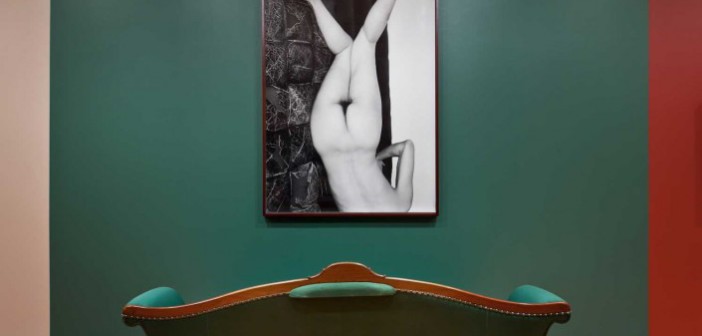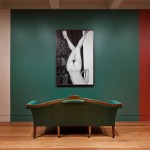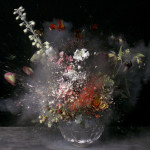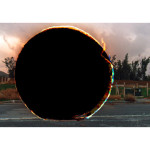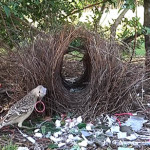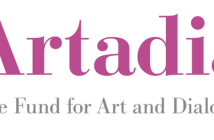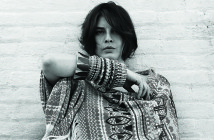Yesterday afternoon at the ICA, Al Miner, Assistant Curator of Contemporary Art at the Museum of Fine Arts, Paul C. Ha, Director of the MIT List Visual Arts Center, Jenelle Porter, Senior Curator at the ICA Boston, and Trevor Smith, Curator of Contemporary Art at Peabody Essex Museum sat down for a discussion moderated by Joanna Fink, President of the Boston Art Dealers Association, backed by a blustery view of Boston Harbor as Hurricane Sandy roared into town. The topic? Boston's art scene present and future. I'll try to summarize an extremely meaty (and refreshingly candid) discussion by recreating the question/answer format. What follows aren't exact quotations but, given the density of my notes, remains reliable paraphrasing.
A customary introduction to each institution's contemporary program began the discussion. At Peabody Essex, Trevor Smith has "declared a free trade zone in the museum." He's been developing a brand new series of contemporary commissions, titled Freeport, that connect past and present within the entire site rather than occupying a dedicated space. Paul C. Ha is working hard to develop the List's connections to the general local public, MIT's student body and faculty, through programming and tours. The List is far better known in New York or Europe than on campus. Jenelle Porter and Al Miner spoke about recent and upcoming exhibition projects.
All the panelists come to Boston from elsewhere: what were their preconceptions about Boston and what have they discovered?
Al Miner mentioned being struck by the city's attachment to higher education and to its position as a seat of thinking and learning. Many people he meets talk about school, their institution and colleagues. Paul Ha used the phrase renaissance to describe the sea change the city is currently undergoing as the amount of institutional space devoted to contemporary art expands. Coming from New York, he was pleasantly surprised to discover the tremendous possibilities. Trevor Smith seconded this thought and added that he is fascinated by the layers of history present in the region. He declared this to be a fruitful and opportune moment to be working here.
What is the greatest challenge they face working here as an art professional?
Jenelle Porter jumped on this question to state that there aren't any. She came to Boston to work for the ICA because she wants to be here. "You couldn't pay me enough to move back and work in New York." She confessed she likes the more intimate art scene and the time people spend in art spaces rather than rushing from place to place. However, she finds there are too few artist-run non-profits and supposes high rents and a lack of City support are to blame. To her, the challenges that exist here are not for the museum professionals but for the artists.
To that point, Al Miner would really like to stop getting nasty-grams from the public who seem perpetually dismayed by the limited number of Boston artists on view at the MFA (even now with three works by local artists on view in the contemporary galleries). Ignoring art made locally may have been the MFA's way at some point, but he no longer finds that to be true. "I hate the term local artist," interjected Ms. Porter. The main goal of any museum is to show the best work. The ICA shows a fairly sizable chunk of artists from here, includes their work in group shows and hosts the annual Foster Prize.
In general though, the panelists tended to agree that Boston doesn't have a healthy alternative art scene that typically feeds the commercial galleries which supply museums. Trevor Smith offered a counter example with Vancouver, a city once with no commercial art scene to speak of, but with a thriving alternative scene including such artists as Jeff Wall and Rodney Graham. These artists took each other very seriously and built a discourse around what they were doing (my Big Red & Shiny ears were pricked.) They reached out to people and institutions abroad with whom they wanted to have a conversation and build connections. So they exploded the traditional model that posits local recognition first, followed by a presence in the national art capital, leading to international exposure. They jumped right from local to international and found their community in Europe, though it took them fifteen years.
How big of a star do you want to be? (Jenelle Porter's accurate rephrasing of a question about curatorial legacy)
Trevor Smith imagines his impact at PEM to be creating connections across historical periods and broad ideas of object making. The western canon of painting isn't the apotheosis of creativity: the Peabody Essex collection includes many kinds of art objects not traditionally regarded as fine art which means contemporary artists get to situate their work within the full breadth of History, not just one version of its telling.
Jenelle Porter believes that building the ICA's permanent collection is paramount and an essential part of her curatorial tenure.
Paul Ha perceives the List as a laboratory for thinking and experimentation and hopes to see the institution in the fray of every major global debate and conversation on contemporary art and ideas.
Al Miner hopes to continue mining the vast holdings of the MFA and weaving them into contemporary exhibits. He spoke about the rich collaborations with colleagues that resulted from the show Ori Gersht: History Repeating.
At this point, the questions came from the audience and, as is often the case at these events, there appeared to be many more artists than collectors, dealers or simply enthusiasts in the crowd. The question of how curators discover new artists was met with candid responses: there are a multitude of ways this happens and given the vastness of the art-world the task of seeing much of the art can seem unsurmountable. Trevor Smith added that the approach to looking for artists depends on the institution: in the case of the PEM meaningful connections have to be found between the collection and the artist's practice. With each Freeport commission he hopes to create something really unique and fitting both for the museum and the artist at a particular point in their career. Jenelle Poster added that when she was curator at Artists Space in New York it was her job to find new and emerging artists - as Senior Curator at the ICA that is no longer her primary role.
Given the amount of conversation focused on the importance of artist-run alternative spaces, it was fitting for someone to ask what makes a successful version of this model. The question was met with a brief history of these spaces, emphasizing that it was groups of artist-friends who created them out of solidarity and necessity (New York in the 70s, the YBAs in London). In Boston the cost of real-estate could be prohibitive - Ms. Porter pointed out that Artists Space was started with a grant from NY Council for the Arts. Many of Boston's artist-coops, and studios for that matter, seem to follow the pay-to-play model (you can show if you can afford it.)
Several voices called out to correct the panelists of their impression that there are no artist-run non-profits here. Kathy Bitetti (Medicine Wheel and Artists Under the Dome) offered to take the curators on a tour, and Al Miner confessed he wished people had reached out to him more and offered an introduction to the scene when he first arrived in the city. The same response came to a question about smaller community museums in neighborhoods like Roxbury and Jamaica Plain: how do communities of color fit into this discussion? Reach over the line was the answer; these smaller institutions need to get in touch. While they rarely have much time outside of the office, curators live and breathe art and remain curious and thirsty to see its endless variety.
Overall it felt like an open discussion at a seat of power with some of its biggest players. It offered a positive picture for the future of large art institutions in this city, tinged with some dismay about an unnecessary artist drain to New York. This exodus seemed unwarranted to the panel given the amount creative activity in colleges and graduate programs, access to ideas, history, technology, (relatively) cheaper space and to the dynamic art programming in the institutions where they work and beyond.
- FreePort [No. 002]: Marianne Mueller Curated by Trevor Smith March 26, 2011 to March 4, 2012. Hilborn and Seamans Galleries Peabody Essex Museum, Salem, MA
- Ori Gersht: History Repeating is curated by Al Miner Big Bang, 2006 Ori Gersht (Israeli, born in 1967) HD film (color, sound) Collection of Lizbeth + George Krupp © Ori Gersht. Courtesy Museum of Fine Arts, Boston
- Amie Siegel Black Moon, Hole Punch #7 winner of the 2010 Foster Prize
- Germaine Kruip Aesthetics as a Way of Survival, 2009. Video still

